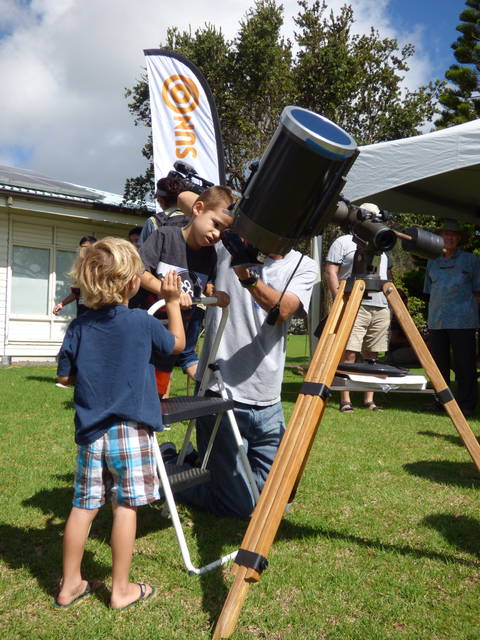WAIMEA — From the offices of the W.M. Keck Observatory to the Canada France Hawaii Telescope, kids and their families took to the solar system Saturday, exploring the planets and other features beyond Earth. ADVERTISING WAIMEA — From the offices
WAIMEA — From the offices of the W.M. Keck Observatory to the Canada France Hawaii Telescope, kids and their families took to the solar system Saturday, exploring the planets and other features beyond Earth.
The Solar System Walk, around for a half-decade now, gives children a chance to get up close with astronomy via a roughly scaled walk of the solar system. But this solar system doesn’t span space, but rather a portion of Mamalahoa Highway from the offices of the W.M. Keck Observatory to the Canada France Telescope headquarters.
The whole walk, from the Sun to the Oort Cloud, measured just less than a mile.
“We really want kids to gain just an idea of the scale of the solar system,” said Mary Beth Laychak, outreach manager for Canada France Hawaii Telescope. “They learn about it in school almost every year, but to actually see it spread out through your town — I’ve had a lot of people comment like, ‘Oh, I didn’t know Uranus was so far away.’”
“We also want the kids to know that those telescopes that are up on the mountain are accessible to them,” she added. “They’re here for them and that they, too, when they grow up, could contribute to some of these discoveries.”
At each stop on their journey, explorers had an opportunity to learn about the planets, sun and other parts of the solar system, including discoveries made right here at home.
Parents said they enjoyed the event because it gave kids an opportunity to learn about the planets in a way that’s different from the classroom.
“It’s not just reading about it; you actually get to see something or do something, actually feel something physically about it,” said Michael Wilkerson of Waikoloa Village.
At the Venus stop, kids learned of a recent discovery about trade winds on the planet.
Keck Observatory support astronomer Greg Doppmann used ping-pong balls and a spinning tray, showing the “winds” — represented by ping-pong balls — curve as they cross a spinning surface in order to demonstrate the trades.
“For me, I think it’s important for kids to realize — who grew up here in Hawaii and especially on the Big Island — that there’s this amazing resource right in their own backyard,” he said.
And if it’s exciting for them, he added, there are careers in their community they can pursue and be a part of exploring the universe.
“I think it’s just a great opportunity for kids to get involved,” he said.
Over at Saturn, astronomers demonstrated a recent discovery about the ringed planet’s magnetic field.
The team had set up a magnet attached to a ruler that sat above an overturned cup.
Kids were then challenged to stack metal nuts vertically, a task made easier by the magnetic attraction of the magnet.
Carlos Alvarez, a support astronomer at Keck, said the activities are designed for children of all ages.
While younger children might only come away with basic facts about Saturn, such as its relative size or characteristic rings, they can still observe the magnet experiment and see science at work.
“They can see that something that they don’t see is producing an effect on something that they can see,” he said. “And basically that’s kind of the whole concept of what is happening on Saturn.”
“Just for them to experiment, I think that’s already an achievement.”
And it wasn’t just planets in the spotlight.
Gary Fujihara, a meteorite hunter, brought a collection of meteorites to the event to talk with kids about the asteroid belt.
Fujihara said he’s been coming out to the solar system walk almost every year, adding he lobbied to get the asteroid belt included as part of the event.
Meteorites, he explained, provide a way to tangibly study the universe in a way telescopes can’t. While telescopes study matter from a great distance, meteorites allow scientists to get up close and personal with it.
“Meteorites allow scientists to hold, analyze, inspect, observe, measure distant objects and derive from them clues that give us insight into how this place within the universe was formed and — where our place within the universe — what it means and where we’re gonna go,” he said.
Fujihara brought meteorites from Russia, Algeria, Morocco and elsewhere. It proved to be a popular exhibit.
“Super cool,” Diamond Punihaole, 7, of Kona, said of the asteroid belt tent after completing the Solar System Walk.
Diamond said he wants to be a scientist when he gets older, specifically one who finds and studies crystals. He nodded when asked if he’d want to be like Fujihara. Science, he said, is his favorite subject.
“‘Cause you get to study everything,” he said.



